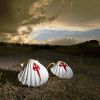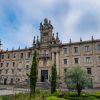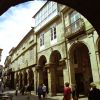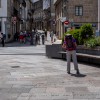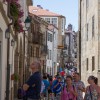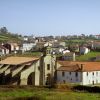- Accede I
- Regístrate I
- carrito
15. Centro Galego de Arte Contemporáneo y convento de Santo Domingo de Bonaval
15. Centro Galego de Arte Contemporáneo y convento de Santo Domingo de Bonaval
Galería de imágenes

El tiempo ha sabido reunir en un solo lugar el pasado y el presente cultural de Galicia.
A nuestra derecha, el antiguo convento dominico de Santo Domingo de Bonaval, transformado en Museo do Pobo Galego, y a nuestra izquierda, el Centro Gallego de Arte Contemporáneo, rodeados ambos por un parque que supo aprovechar la presencia de la huerta monacal para crear una zona verde en pleno centro urbano. Los dos museos y el parque constituyen tres visitas obligadas en Santiago.
Se atribuye la fundación del convento al propio Santo Domingo de Guzmán, que, según la tradición, quiso concluir su segundo viaje a tierras del Apóstol con el establecimiento de una comunidad religiosa en 1220, poco antes de su muerte. El edificio actual del convento es, en buena parte, obra del arquitecto barroco Domingo de Andrade, quien diseñó además la sorprendente triple escalera de caracol sin soporte que se puede admirar en el interior. La técnica y belleza de sus tres rampas independientes la convierten en uno de los elementos más singulares del patrimonio arquitectónico de Santiago.
Tras pasar por varios usos, el de convento, auspicio y colegio de sordomudos, en 1977 el edificio acogió la fundación del Museo do Pobo Galego, el primer museo antropológico de Galicia. Las salas están dedicadas al mar, al campo, a la arquitectura popular, los oficios, los tejidos, la artesanía y la música. También tiene secciones de arqueología y organiza exposiciones temporales sobre la historia y la vida cotidiana de Galicia.
La Iglesia de Santo Domingo de Bonaval, por su parte, es una obra de transición entre el románico y el gótico. Dentro de este templo, en el llamado Panteón de Galegos Ilustres, reposan -entre otros- los restos mortales de Rosalía de Castro y de Castelao, figuras clave de la identidad y la cultura gallega.
El Centro Gallego de Arte Contemporáneo, a nuestra izquierda, ocupa el edificio de granito diseñado por el afamado arquitecto portugués Álvaro Siza, e inaugurado en 1993. Su disposición está estudiada para no ocultar la vista del convento barroco, con el que crea un armonioso contraste. La línea, la luz y el volumen son los elementos que se combinan para dar paso a una arquitectura austera y serena, que se sirve de la piedra como elemento de unión con la tradición de Compostela. Los luminosos espacios interiores se abren como un abanico para mostrar las líneas directrices del arte de las últimas décadas, especialmente a través de su colección permanente formada por más de 1200 piezas. La convivencia y el diálogo entre obras de artistas gallegos e internacionales es el signo distintivo de estas propuestas.














